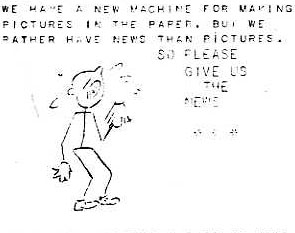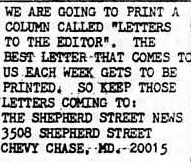Tricks of the Trade:
Learning the Newspaper Business
The Thornapple Street News November 14, 1931. CCHS 1989.27.01.
The Chevy Chase children's newspapers were not merely ways to have fun. The young reporters took their work seriously and put a tremendous amount of effort into producing their newspapers each week. They gathered news stories, chose content, produced the newspaper and distributed it throughout the local community and beyond. Through this process they gained valuable skills in inquiry, interpersonal communication, social skills, decision making and meeting deadlines.
The community provided safety and support, as well as encouragement from parents and neighbors who took the newspapers as seriously as the children did.
In this section, we explore the four key steps in making a newspaper:
Reporting
Editing
Production
Distribution

Reporting
Whether it was The Thornapple Street News reporters going door to door or The Leland Street Sunday News reporters making their weekly telephone calls, the neighborhood could depend on the young reporters making the rounds to gather the news. The children got stories and updates on visitors, home repairs, pets, vacations and more.
All editors wanted information that was new and interesting, but the newspapers differed in the types of questions their reporters asked. Based on the content of the newspapers themselves, The Thornapple Street News and The Shepherd Street News asked more open-ended questions, while The Leland Street Sunday News frequently asked the same three questions every time:
"New Jobs? New Pets? New Appliances?"
The doorstep interview seemed to be a favorite part of the process for the young reporters, although the job was not without its downsides…
The Thornapple Street News, December 10, 1932. CCHS 1989.27.01.

The Letters to the Editor weekly column gave readers a chance to share, opinions, stories and community updates that went beyond the questions the staff may have asked; they give insight into Chevy Chase life in the 1970s.
Neighbors took the work of the young reporters seriously, whether it meant welcoming the children into their homes, or answering the reporter's call (or sometimes desperate plea) for news and opinions. The neighbors were actively involved in providing the children with their news, and sometimes their responses show just how delightful it was to be interviewed…
The Shepherd Street News, July 29, 1972. CCHS 1989.27.01.
"REMEMBER…SUGGESTIONS, RECIPES, CROSSWORD PUZZLES, LETTERS TO THE EDITORS AND JOKES, RIDDLES AND SAYINGS ARE ALWAYS WELCOME. ALSO, IF YOU HAVE ANY THING THAT YOU ESPECIALLY WOULD LIKE PRINTED IN THE LELAND STREET SUNDAY NEWS, PLEASE PREPARE IT AHEAD OF TIME AND GIVE IT TO THE EDITORS OR CALL THEM UP AND TELL THEM. THANK YOU."
The Leland Street Sunday News, March 23, 1975. CCHS 2010.1015.02.
Editing
Given their limited amount of time and actual page space available, the young reporters had to make decisions about what to place in their paper. The newspapers were first and foremost an opportunity for the children to have their interests and voices heard.
Each newspaper contained its own combination of local and international news. Some reporters (or adult interviewees) were interested in politics and current events more than others. The Thornapple Street News in the 1930s contains more international news than the other two newspapers, reflecting not only a neighborhood aware of wider events such as the Great Depression, but a world on the brink of another global war. The Thornapple reporters watched the movements and events of particular countries with increased interest:
Reporting on such a diverse range of issues required honesty on the part of the reporters and taught them discernment in which stories would be appropriate for their newspaper. For the most part, however, they seemed to follow the wise words of Leonard Williams, recorded in 1975:
An Interview with Leonard Williams, The Leland Street Sunday News, March 16, 1975. CCHS 2010.1015.02.


